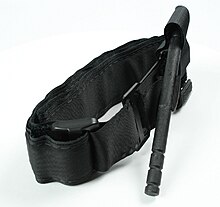Tourniquet
A tourniquet (French. For hub , also tourniquet ) is a setting system , which can be jammed by the flow of blood in the veins and arteries (depending on the pressure), or completely interrupted. It is the next option after a pressure bandage to treat bleeding, especially multiple penetrating injuries.
Areas of application
In venography and other methods of examining the venous system , it is used at low pressure to congest the superficial veins.
In orthopedics and trauma surgery, a controllable pneumatic tourniquet is regularly used in extremity surgery in order to be able to operate without blood .
The tourniquet has also gained more and more importance in the field of civil rescue. This is why the tourniquet is held in more and more vehicles of the rescue service and also with police members, since according to current studies the lethality rate due to high blood loss in traumatic events is very high. In the case of life-threatening bleeding that cannot be controlled with a pressure bandage, the tourniquet should also be used as a last resort and life-saving device in the civilian sector. Police officers at the state and federal police are now also trained on this measure (also for personal use).
In the military, the tourniquet is used as part of Tactical Combat Casualty Care (TCCC) to stop a large or multiply penetrating and heavily bleeding wound on an extremity, especially after explosion injuries, e.g. B. by splinters or bombs. In the event of gunshot and explosion injuries to extremities, including those with traumatic amputation , it is also useful in the civilian sector for temporary ligation, especially if several injured persons have to be treated at the same time or large penetrating injuries, as this directly prevents the risk of bleeding to death.
The use of the tourniquet during the Iraq and Afghanistan wars reduced lethality from explosion injuries to extremities, as this prevented massive blood loss and, above all, bleeding to death with multiple penetrating injuries.
Tourniquets have also been used as equipment on ambulances in the German federal states of Baden-Württemberg and Bavaria since September 2016 . Soldiers of the German Armed Forces deployed abroad are equipped with tourniquets; some police officers use it as part of their personal first aid kit.
history
Compression straps for controlling bleeding are known both from the traditions of Greek scholars and from the Roman Empire. Military surgeons used these to control bleeding during amputations.
In 1718 the French surgeon Louis Petit developed a mechanical instrument with a tensioning screw, which he called a tourniquet ( tourner = to turn).
The rubber bandage or the tourniquet made of flexible material goes back to an invention by Johann von Esmarch in 1873. The advantage over the development by Louis Petit lay in the material (flexible rubber) and in the fact that there were no longer any mechanical parts that could come loose. A tourniquet, later a tourniquet made of fabric tape, was in vehicle first aid kits until the end of the 1970s, but was removed there from the 1980s.
function
The modern tourniquets work either pneumatically or mechanically.
The pneumatic tourniquets are similar in appearance and function to a blood pressure cuff. Air is pumped into a balloon that is incorporated into a cuff in order to achieve the necessary pressure.
The mechanical tourniquets all work by shortening a ligament through rotation. A toggle attached to a rotating belt is turned. This shortens the tape and creates the necessary pressure.
Both types have advantages and disadvantages. The tourniquet can cause injuries such as bruises and bruises. In the rarest of cases, there is long-term or permanent damage to nerves and tissue. A temporary ligation of up to two hours often does not have any serious consequences, but the death of the relevant extremity and the absence of normal blood flow after removal of the tourniquet cannot be completely ruled out. On the other hand, there are also reports of soldiers who had worn the tourniquet for 16 hours after being wounded.
The main risk of use is the formation of blood clots. Once a tourniquet has been put on, it should only be removed under medical supervision. The date and time of the ligation should be noted on the tourniquet or on the patient with a felt pen. In civil first aid - with the exception of gunshot wounds - deployment is not or only rarely required.
See also
Individual evidence
- ↑ JF Kragh, ML Littrel, JA Jones, TJ Walters, DG Baer, CE Wade, JB Holcomb: Battle casualty survival with emergency tourniquet use to stop limb bleeding. J Emerg Med. 2011; Volume 41, Issue 6 of December 2011, pages 590-597; doi : 10.1016 / j.jemermed.2009.07.022 .
- ↑ Terror set for ambulances: Why this is not a luxury . In: https://www.merkur.de . September 21, 2016 ( merkur.de [accessed July 18, 2017]).
- ↑ Better equipment for rescue services and disaster control in the country. Retrieved July 4, 2019 .
- ↑ Archived copy ( memento of the original dated November 1, 2008 in the Internet Archive ) Info: The archive link was inserted automatically and has not yet been checked. Please check the original and archive link according to the instructions and then remove this notice.
- ^ S3 guideline polytrauma - AUC. Retrieved July 4, 2019 .
